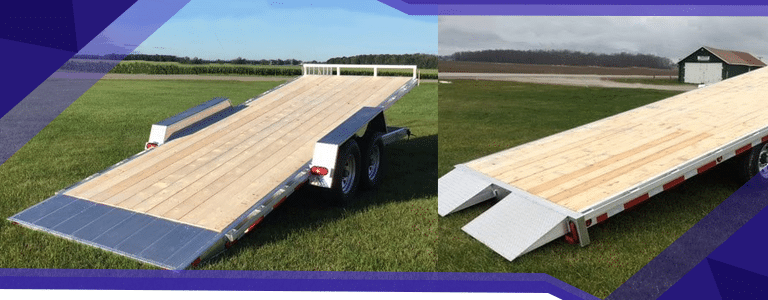
How To Load Equipment Onto a Flatdeck Trailer
You’re shopping for a custom flatdeck trailer to carry equipment, so be sure you choose a trailer that fits the bill. A flatdeck trailer gives you plenty of space for recreational vehicles, heavy equipment or boxes and furniture for a big move. While these trailers have plenty of towing capacity and space, the flatdeck design means you’ll need to know the right way to load your equipment. Use the following tips before shopping for trailers at Millroad Manufacturing.
Watch Your Weight
There are a few key weight limits you need to know. Overloading your trailer or loading it off-balanced can reduce your braking, acceleration, handling and safety. The last thing you want to see is your expensive equipment sliding off the side of a flatdeck, so check out these figures:
- Overall trailer weight rating
- Axle weight rating
- Tongue weight
- Equipment weight
- Truck towing weight
- Road weight limits
If you’re just carrying a few ATVs or a few couches, you won’t have to worry about road weight limits, but oversized loads may not be allowed on backroads or even county roads in your area. Your towing situation is only as safe as the weakest link, so be sure you know your truck’s towing limit, the limits of the axle and overall trailer limit.
An unsecured or overweight load can be a serious issue for you and everyone around you. A sliding box, barrel or ATV can cause some major damage to another vehicle, so drive responsibly and stay safe out there.
Position Your Load
Once you’re done with the math and ready to get started, it’s time to start loading your trailer. If you have a lot of different items or a particularly heavy piece of equipment, you’ll want to carefully consider the best way to position the load.
Try to spread the weight evenly from side to side. This will prevent your trailer from wandering in one direction as you drive. Spread out the weight between your axles. It’s typically better to have the weight centred slightly in the front of your trailer but use caution that you don’t overload the tongue.
If you’re starting to pile up your load, keep heavier items on the bottom. This isn’t as much of an issue with a flatdeck trailer, but it’s an important feature to consider when packing up any truck or trailer.
Compare Ties and Covers
Load up your flatdeck trailer and consider how you’ll keep it there. The flat sides of this trailer type make it easy to access your load from all sides, but it also makes it easy for a few boxes or spare tires to bounce down the highway.
Most loads are safely secured with tie-down straps, chains or a cover. Here are some ways that you need to compare straps for your load:
- Weight rating
- Length
- Material
- Tie-down points
For cylindrical loads, use netting to keep them from shifting under your straps or chains. Check your equipment or vehicles to find the best place to wrap a chain around that will keep it secure and won’t scratch or damage your load.
Inspect your trailer to find the right tie-down points. Many straps and chains fail not because they are too weak but because they are latched onto a weak point on a trailer. Proper D-ring or other points keep your strap tight and secure.
Choose the Right Trailer
At Millroad Manufacturing, we have the right trailer for your hauling needs. Check out our flatdeck trailers today to see how you can enjoy premium aluminum designs and rugged decking for a dependable surface. If you can’t find the trailer that fits your hauling needs, work with us to create a custom option.